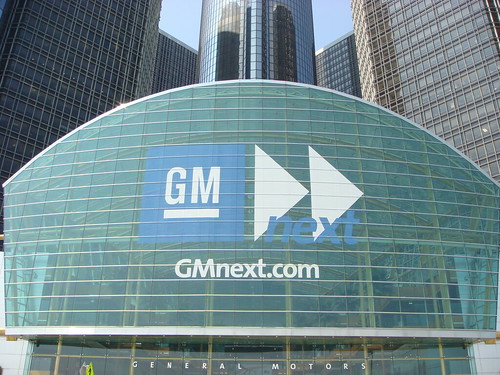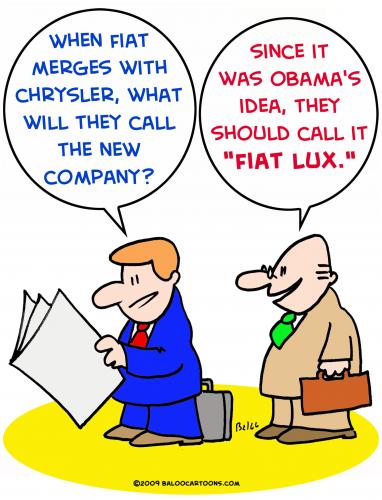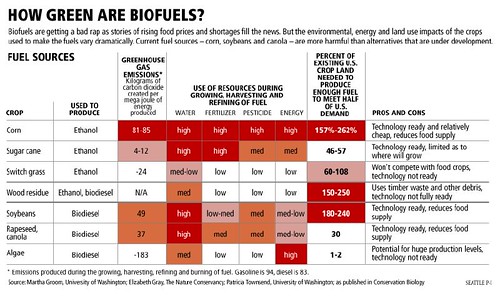Scoopful of GM and Chrysler News – May 8, 2009
White House Sees U.S. Holding GM Stake for At Least 2 Years The Obama administration is planning for the U.S. government to hold an ownership stake in a revamped General Motors for “at least two years,” a person briefed by the administration on its plans said Friday.
 Transportation Secretary Ray LaHood says GM in ‘good hands’ – The Detroit News…LaHood says GM in ‘good hands’The Detroit News, MIWashington — US Transportation Secretary Ray LaHood Friday endorsed General Motors Corp.’s new CEO as the right man to lead the Detroit automaker, saying, “GM is in very good hands.” Fritz Henderson took over as CEO on March 30 after the Obama …California in running for h…
Transportation Secretary Ray LaHood says GM in ‘good hands’ – The Detroit News…LaHood says GM in ‘good hands’The Detroit News, MIWashington — US Transportation Secretary Ray LaHood Friday endorsed General Motors Corp.’s new CEO as the right man to lead the Detroit automaker, saying, “GM is in very good hands.” Fritz Henderson took over as CEO on March 30 after the Obama …California in running for h…
More GM Cuts: Cadillac STS-V and Pontiac G6 GXP both gone for 2010…GM, Pontiac 2009 Pontiac G6 GXP Sedan – Click above for high-res image gallery Pluto, the Roman god of Hades, is currently on a tour of the General Motors product garage and he’s taking a few cars with him from the land of the living. After sending the Impala SS and the Cobalt SS to the underworld, he has just added to his collection the Cadilla…
Toyota hammered with $7.7B loss in Q1 …than even GM‘s just-reported loss of $6 billion. Toyota now expects to lose $5.5 billion for the year ending March 2010, surpassing the $4.4 billion it lost in the just-concluded year.The reasons for Toyota’s reversal of fortune is well documented. Global sales were down 21.9% last year, with the most stark losses occurring in the U.S. and Europ…
Song remains the same: GM loses billions, Volt still on track…res gallery GM‘s announced yesterday that it lost $6 billion in the first quarter of 2009. That’s par for the course for the General these days. What’s also pretty standard was the immediate confirmation that work on the Chevy Volt is going A-OK and that, as GM‘s product development chief Tom Stephens said, “At this point in time, I know of no r…
Toyota First Quarter Losses Higher Than GM [Carpocalypse]…more than GM lost! That’s some pretty big news — especially considering GM dropped $6 billion during the first quarter. Jeez, if only Toyota were building some fuel-efficient, dependable appliance-type vehicles, right? [Reuters, WSJ]
GM and U of M create new institute for research …GMGeneral Motors and the University of Michigan have been working together on vehicle technology for 50 years, and a new institute will take the long-standing relationship to the next level. GM researchers will work with U of M faculty and students to develop new battery, engine, manufacturing, and smart materials technology to expedite the adva…
Sandia Successfully Completes Hydrogen Storage System for GM…designed for GM. To the right is the “SmartBed,” featuring a thermal management system with individual control of four identical modules, each of which is a shell and tube heat exchanger. The sodium alanate material used to store the hydrogen resides within the tubes. (Photo by Randy Wong) Click to enlarge.Researchers at Sandia National Laborato…
Nissan skipping SEMA this year, Mazda limiting presence Filed under: Aftermarket, SEMA, Tuners, Mazda, Nissan, Holden Troy Lee Designs Mazda6 from SEMA 2008 – Click above for a high-res image gallery Participation at last year’s SEMA show was notable for its absences, with the event’s organizers struggling at the last minute to fill vacated floor space with companies that would have normally been shunne…
Booo! GM also canceling Cobalt SS Sedan for 2010 …GM also canceling Cobalt SS Sedan for 2010
G.M. Suffers Big Loss. Is Bankruptcy Next?General Motors could be one step closer to bankruptcy, after posting a $6 billion loss for the first quarter. The Obama administration’s auto task force has given G.M. until June 1 to come up with a plan to prove its viability. After reporting a 40 percent loss in worldwide sales, G.M. doesn’t seem likely to do […]
Save the Cheerleader? GM creates Hero Edition Corvette ZR1 to benefit Kids Wish Network…GM‘s team of Corvette designers and engineers equipped this particular ‘Vette with a bespoke graphics package with red accents in lieu of the normal blue. Other special bits include “additional carbon fiber components,” though we’re left wondering what those composite pieces may be.You can’t actually go to your nearest Chevy dealership and order…
 The Chrysler Building: Biggest Mopar Ever [Carpocalypse]…all know Chrysler‘s facing some rough times, but let’s turn back the clock to 1930 and talk about the biggest Chrysler ever built.Chrysler Corporation was growing and in desperate need for — something — to represent its achievements. What better place to shine than New York City. Designed by architect, William Van Alen, the Chrysler Building wa..
The Chrysler Building: Biggest Mopar Ever [Carpocalypse]…all know Chrysler‘s facing some rough times, but let’s turn back the clock to 1930 and talk about the biggest Chrysler ever built.Chrysler Corporation was growing and in desperate need for — something — to represent its achievements. What better place to shine than New York City. Designed by architect, William Van Alen, the Chrysler Building wa..
Rendered Speculation: Alfa Romeo Milano, the next 147…the next Chrysler Sebring. The versatile building block will offer various lengths and widths in FWD and 4-wheel-drive versions, and propulsion will be courtesy of MultiAir engines. Unveiling of the 5-door hatchback is expected at either Frankfurt later this year, or Geneva in 2010.[Source: Car]Rendered Speculation: Alfa Romeo Milano, the next 1…
Chrysler reveals more facets of “We Build” campaign…Chrysler, LLC. Click above to watch all five commercials after the jump Chrysler sales have been abysmal throughout 2009, and with the uncertainty of bankruptcy, the short-term sales outlook is decidedly bad. To get the word out to its customers that the Pentastar is alive and well (except for its idled plants), Chrysler is launching a new campa…
Classic Ad: Chrysler’s Promise of a Small Car…Chrysler‘s former chairman, Lee A. Iacocca, makes some lofty promises in this 1984 commercial, including the introduction of a small car. Will we hear the same from Fiat’s chief executive, Sergio Marchionne?
Greenlings: Can we build a better battery with lithium?…Chrysler ENVI battery packsGallery: Tesla smart mule and batteryContinue reading Greenlings: Can we build a better battery with lithium?Filed under: Emerging Technologies, Etc., EV/Plug-in, Hybrid, GreenlingsGreenlings: Can we build a better battery with lithium? originally appeared on AutoblogGreen on Thu, 07 May 2009 19:52:00 EST. Please see …
Nissan skipping SEMA this year, Mazda limiting presence…out on Chrysler, and Honda is currently evaluating their presence, although it may be reduced compared to previous years. No matter what automakers pull-out of this year’s show, expect less products on tables, fewer vendors on the floor and even fewer attendees as the aftermarket continues to struggle to keep its head above water.Gallery: SEMA 2…
Misery loves company: Throwing our wig into the ring at Reno-Fernley LeMons…onto any Chrysler product “competing” in Reno to honor the automaker’s latest union.Registration ended on March 14, so those of you who missed the deadline narrowly avoiding our cold steel scythe of justice. But if you want to come out and enjoy the madness, spectator tickets are available for either a single day or the entire wretched weekend. …
The 2011 Jeep Phoenix… why not?…gallery With Chrysler‘s proposed alliance with Fiat all but a done deal, people have begun turning their attention towards the Italian automaker’s vehicle line up and creating a wish list of which ones they’d like to see for sale over here in the U.S. Thing is, those people should keep in mind that any Fiat making the long trek overseas may not …
Chrysler Plan’s Foes Step BackA group of Chrysler lenders who opposed the government’s restructuring plan for the auto maker is disbanding after two of its five members backed out.


 May 7, 2009-The National Hydrogen Association (NHA) and U.S. Fuel Cell Council (USFCC) issued the following joint statement regarding the Obama Administration’s FY 2010 budget request for the U.S Department of Energy:
May 7, 2009-The National Hydrogen Association (NHA) and U.S. Fuel Cell Council (USFCC) issued the following joint statement regarding the Obama Administration’s FY 2010 budget request for the U.S Department of Energy:





